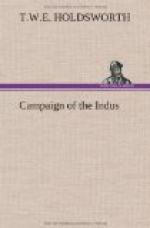After making two out of these three, (and precious
long ones they were,) we found out that we were still
upwards of twenty miles from Ghuzni, with the men
so fatigued that it was nearly impossible for them
to do it, and that we should therefore be obliged
to make two of it. The event, however, proved
the contrary; for, about seven o’clock in the
evening, a dispatch came from General Willshire, and
about eight, just as we were preparing to turn in,
the orders were out to strike our tents, and march
in an hour’s time, and catch up Sir John Keane
and the Shah, who were halted about nine miles in
advance of us. Sir John was anxious to have the
whole force concentrated before marching on Ghuzni.
Nothing, however, was certain; and we were all in a
high state of excitement, not knowing what to expect:
this was the evening of the 20th. We made quick
work of this march, and reached Sir John Keane about
half-past twelve. Here we heard that Sir John
Keane was in expectation of a night attack. He
had fallen in that morning with the advance of the
enemy, who had, however, upon the appearance of the
British force, retired upon Ghuzni. We bivouacked
on our ground, after throwing out strong pickets,
and marched again at 5 A.M., Sir John Keane, the Bengalees,
and cavalry in advance, then the Shah, and then our
small party. We, however, sent our artillery
to join Sir John. About eight o’clock,
when within about three miles of Ghuzni, we heard the
first symptoms that the game of war was beginning:
our batteries were firing on the place, and the garrison
were returning it with good effect; it served as a
sort of overture to the opera in which we knew we must
soon be actors.
In consequence of the great quantity of baggage, now
the whole army was joined, we were halted for a couple
of hours to protect it, and the whole of the cavalry
was sent back for that purpose; and well it was that
they were, as a part of the enemy’s cavalry made
a demonstration for attacking it, but withdrew on
seeing ours. We were at length marched on, and
took up our ground a little to the S.W. of the fort,
but out of harm’s way, when we heard a more
definite account of what had been done. The advance
of the Bengal column, H.M. 13th Light Infantry and
the 16th Native Infantry, had some little work in
driving the enemy out of the gardens and old buildings
that surround the town. This, however, they accomplished
with a trifling loss; our guns then opened on the place,
but as they were light ones (the heaviest being still
in the rear), with little effect. This desultory
fire on both sides was, however, kept up for about
three hours: little execution being done, and
a few casualties having occurred among the artillery,
Sir John Keane ordered the guns to be withdrawn.
We had not been on our ground more than three hours
when we were ordered once more on the march, and to
march by a circuitous route across the mountains,
in order to avoid the fire of the town, and take up
our ground on the other side of it. We reached
our new ground about nine, after a fatiguing march
of seven miles, crossing the river, and, by an infernal
path, through the hills. Here we bivouacked again
for the night, as little of our baggage had arrived.




